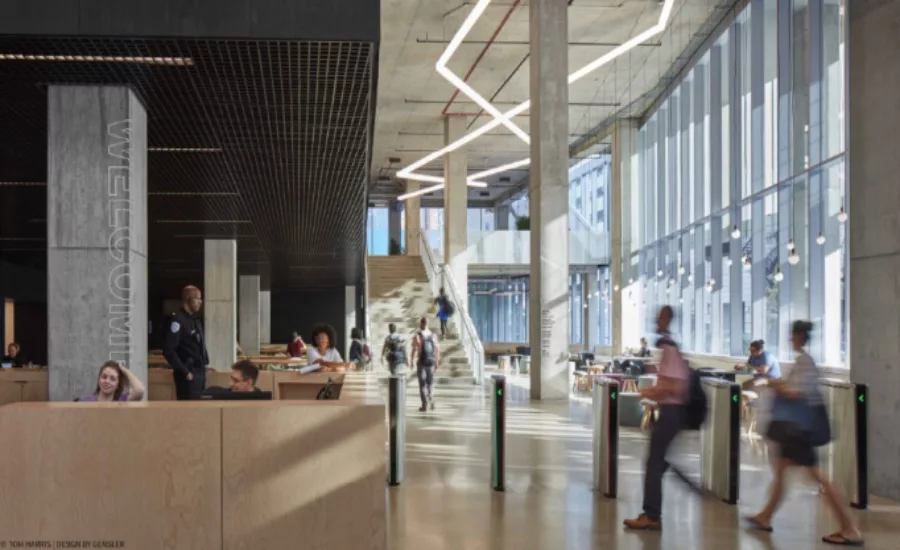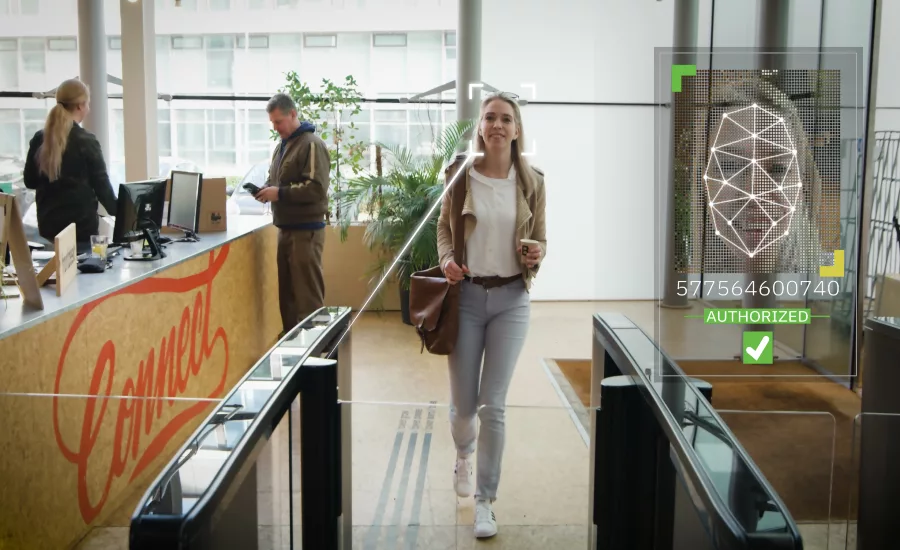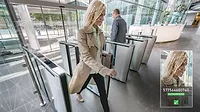Touchless access control solutions look to alter the landscape of higher education
New and innovative access control and secured entrance options take center stage on college campuses

New and innovative access control and secured entrance options take center stage on college campuses. Image courtesy of Boon Edam

Touchless access control devices allow secured ingress and egress using a variety of technologies that can grant authorization to enter a certain area without requiring physical contact with a device or a shared unlocking apparatus like a key or an identification card. Image courtesy of Boon Edam

Other options like automatic, optical turnstiles allow contactless entry without compromising security. These turnstiles have swinging or sliding barriers that open for authorized users to proceed into a lane, and then close relatively swiftly. Image courtesy of Boon Edam
The headlines in state newspapers around the country tell the story of the impact COVID-19 is having on higher education campuses. Within the last two months, institutions including the University of West Virginia, the University of Missouri, Kings College, Michigan State, University of Chicago, Princeton University, Williams College, Spelman College, and American University have either gone fully online or have moved a large percentage of students to online studies and discounted tuitions to help them weather the financial impact of the pandemic.
The question of whether opening college campuses this fall was the safe and prudent move has also taken on some polarizing aspects reflective of the divisive political state of the nation. According to a recently released Pew Research Center survey related to reopening the nation’s colleges and universities, it was found that Republicans and Democrats differ in their views about the severity of the public health crisis, restrictions on businesses and other public activities, and mask wearing. In the current poll, 74% of Republicans say schools that are currently providing in-person instruction made the right decision in bringing students back to campus this fall; only 29% of Democrats say the same.
Ready Or Not, We Are Back – Sort Of
However, the reality is that most institutions of higher learning have decided to open their campuses this fall regardless of the political rancor, adding the specter of a deadly pandemic to an already challenging campus security environment where campus shootings, physical violence to women and theft usually occupy the top threat metrics for college security administrators. Because college and university campuses have thousands of students and faculty traversing a wide swath of buildings all day, every day, having an access control solution that not only addresses the security aspect of this population, but now one that must also handle myriad safety and health concerns due to COVID-19 to lessen the likelihood of the virus spreading, is a top priority.
Unfortunately, the haphazard and inconsistent way both federal and state governments have approached guidelines and health enforcement mandates to control this deadly coronavirus has made the situation even more challenging. The uncertainty has already severely impacted the planning and mitigation efforts to subdue the virus and enhance the support of remote-based productivity and learning. With social distancing queues, mask requirements and detection monitoring just to name a few of the changes students are seeing, campus life had already begun to morph into something different because of increased security technology and monitoring. These changes have been accelerated as routine campus activities like large lecture hall discussions, Greek life and collegiate athletics have been quickly supplanted by mitigations such as COVID-intense temperature screening, contact tracing, occupancy controls and people tracking.
Additionally, campus security and facility administrators are keen on reducing the surface touchpoints of their access control systems and door entrances.
Touchless Access Control is No Stranger
Touchless access control has been around for decades in the form of proximity access cards and biometrics like iris scanners, facial recognition, and other devices. But the current definition of touchless door access is simply the latest innovation in an ever-evolving method of safeguarding sensitive areas and securing students and staff.
Touchless access control devices allow secured ingress and egress using a variety of technologies that can grant authorization to enter a certain area without requiring physical contact with a device or a shared unlocking apparatus like a key or an identification card. College and university campuses have been implementing touchless door access controls like mobile credential apps that reside on an employee’s smartphone that monitors their level of access authority into high-security areas like labs and data centers in recent years and have done the same with students who can now use their mobile app as a frictionless access device as well as a debit card. Biometrics are also gaining a higher profile because of their touchless nature in the form of facial recognition software and iris readers. Couple the access control modalities with innovations like doors that open automatically when an authorized person attempts to gain access, eliminating the need for door handles, a frictionless solution can be achieved.
Let Me Show You The (Security) Door
Another traditional and common use of touchless technology employed by college campuses are automatic sliding and swinging doors with hand-wave sensors. When it comes to new lobby designs in university buildings like libraries, administrative offices, student unions and sports arenas, touchless entry is no longer a suggestion but a requirement. Emerging COVID-19 safety mandates state that it is important that users not have to touch door surfaces, handles, knobs, and buttons if at all possible. It is also essential that any new lobby design must provide an automated entry experience without compromising on security.
The continued surge of the coronavirus pandemic has increased the urgency of extending the scope of touchless environments motivating many facilities to begin researching ways to make all their entrances automatic. One solution that has been considered is retrofitting existing manual swing doors with low-energy, electric operators, which are typically used with wide doors for disabled and wheelchair access. They must open a full, 90 degrees and then close slowly to allow the disabled to safely enter. While this can be an easy and timely fix, the issue with any automatic swinging or sliding doors is that they do not deter or detect the infiltration of unauthorized users via tailgating.
Other options like automatic, optical turnstiles allow contactless entry without compromising security. These turnstiles have swinging or sliding barriers that open for authorized users to proceed into a lane, and then close relatively swiftly. While it may not be practical to replace every swing door in a building with a turnstile, an alternative to consider would be deployment of the turnstiles at key locations inside a building as part of a layered physical security strategy. An extra layer of security that is integrated into security entrances is their ability to approve or deny access based on the data they receive from an access control system. While scanning an RFID employee badge/proximity card at a turnstile is a very common way of entering a building, other credential or identity verification technologies support touchless entry in addition to the biometrics previously mentioned like hand-wave technology for contactless fingerprint scanning and Bluetooth credential apps on mobile phones. Since these solutions may take a second or two to confirm identity, security planners should factor in this extra time when planning for the right throughput to accommodate traffic needs.
While security entrances are an effective way to deter, detect and prevent unauthorized entry due to tailgating, their safety can also be enhanced with antimicrobial finishes or special films to control germs and kill microbes on contact, in addition to regular cleaning and disinfecting.
And a Turnstile Shall Lead Them
As the need for social distancing increases and university security staffing could be impacted by possible budget cuts, having the ability to monitor and control student and staff traffic in certain buildings with less security personnel on duty is an advantage. Optical turnstiles are automatic solutions that can be outfitted with automatic swinging or sliding barriers and touchless credential readers for hands-free entry. To support social distancing and decreased building occupancy levels now, organizations could install a large array of optical turnstiles to handle future building traffic, and then “turn off” every other turnstile now, forcing users to spread out. This allows a facility to build and design for long-term occupancy needs, while also addressing current needs during a pandemic. Another health and safety approach for new construction is to plan to stagger or fan out the turnstiles and use railing and glass in between them. Keep in mind that optical turnstile solutions will issue an alarm when tailgating or unauthorized entry happens and are therefore most effective when used in conjunction with nearby guard staff to confront intruders. Other technologies that can increase security and entry efficiency are security cameras, elevator dispatch systems and visitor management systems.
Looking Ahead
The tsunami of innovative and new touchless access control technologies like wave-to-open door sensors, mobile credentials, contactless fingerprint sensors, iris scanners, facial recognition, various types of wearables and touchless turnstiles and security revolving doors demonstrate the just how adaptable the security marketplace is when faced with a crisis. These new alternatives to traditional access control offer colleges and universities – and other organizations – an opportunity to change the safety and security footprint of their facilities and help earn back the confidence and trust of students and staff to return to a safer campus.
This article originally ran in Security, a twice-monthly security-focused eNewsletter for security end users, brought to you by Security Magazine. Subscribe here.
Looking for a reprint of this article?
From high-res PDFs to custom plaques, order your copy today!








